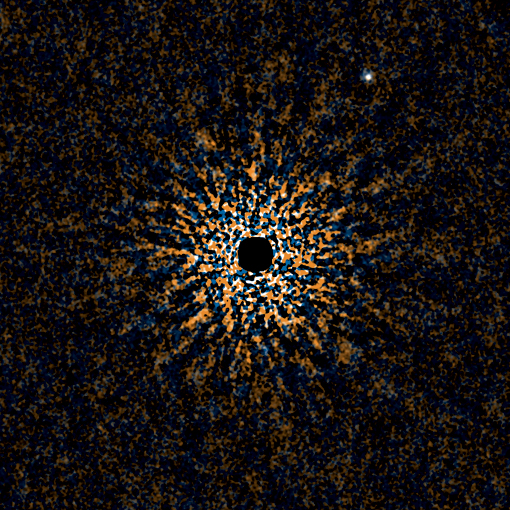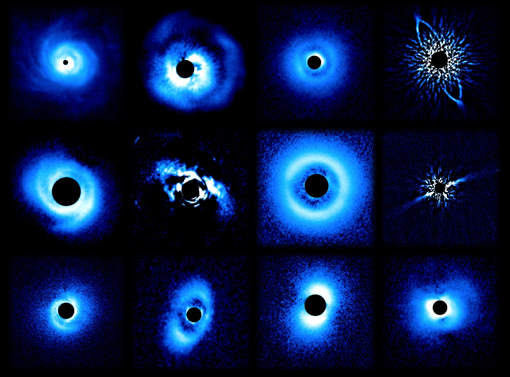|
|
MPIA Science Release 2013-07 Monday, August 5, 2013, 8:00 MESZ |
|
| German version |
One step closer to imaging distant Solar systems: Subaru telescope snaps image of "cold Jupiter" GJ 504 b
A group of astronomers including scientists from the Max Planck Institute for Astronomy has taken an important step towards producing images of distant planetary systems that are similar to our own Solar system: Using the Subaru telescope on Hawai'i, they took an image of the jupiter-like planet GJ 504b. This is the first image of a planet orbiting a Sun-like star (spectral type G), and it is the coldest and could also be the lightest planet yet imaged.

|
Figure 1: Near-infrared color composite images of a "second Jupiter" around the Sun-like star GJ 504 taken with the Subaru telescope. Light from the star, which would be in the center, has been suppressed mechanically and by image analysis methods. This is the coldest and possibly the lightest exoplanet ever imaged, and the first image of a planet orbiting a Sun-like (G type) star. Image credit: NAOJ [Larger version for download] |
| Contact | Background information | Images |
To date, astronomers have confirmed the existence of nearly 930 exoplanets (that is, planets orbiting stars other than the Sun). Almost all of them have been detected only indirectly, by the pull they exert on their host star, or when they block part of their host star's light.
But if, say, extraterrestrial astronomers were to observe our own Solar System with those indirect methods, they would miss out on a number of its most intriguing aspects. In particular, they would be likely to miss the slow-moving outer planets. This is where methods such as direct imaging of exoplanets – observations producing images on which the planet is clearly identifiable – can help. Such images also give information about a planet's temperature and atmosphere. Direct spectroscopy (currently in its infancy) would yield detailed information about the atmosphere's chemical composition.
That is why astronomers (here on Earth) are so keen to develop methods for direct imaging of exoplanets – they are a key element of the strategy to detect and examine distant analogues of our own Solar System. Obtaining direct images is, however, a difficult task. Stars are much brighter than their planets (typically by a factor of a billion or more); using traditional observational techniques, the planet will be hidden in the glare of its host star. Only with sophisticated tricks – such as blocking out the star's light mechanically (coronagraphy) and combining several images in just the right way to reduce spurious signals – can astronomers obtain these images at all.
Now a group of astronomers led by Motohide Tamura (National Observatory of Japan [NAOJ] and Tokyo University), which includes several astronomers from the Max Planck Institute for Astronomy (MPIA), has come an important step closer to detecting far-away analogues of our own planetary system. Using the Subaru Telescope in Hawai'i, they were able to obtain direct images of a Jupiter-like planet, GJ 504b, orbiting the star GJ 504 in the constellation Virgo, about 60 light-years from Earth. The distance of GJ 504b from its star amounts to 44 times the distance between the Earth and the Sun (44 AU). GJ 504b is thus comparable to that of Neptune within our own Solar System.
This is the first image of a planet orbiting a Sun-like star (spectral type G); previous observations had targeted more luminous stars that tend to host more massive planets, which tend to be hotter and thus more easily detectable. Estimates of the planet's mass are linked to estimates of the age of its host star. The estimate favored by most of the researchers would put the mass in the region of 3 Jupiter masses, which would make this the lightest planet yet imaged. Going by the observations, this is also the coldest exoplanet yet detected in an image.
The discovery was made as part of the SEEDS project ("Strategic Explorations of Exoplanets and Disks"). It comes at a time when SEEDS is looking back on completing the first half of the project's observing program – which has yielded remarkable images not only of planets, but also of the disks of gas and dust that surround young stars.
The Max Planck Institute for Astronomy was one of the co-founders of the SEEDS survey. MPIA director Thomas Henning explains: "With the unique experience in observing strategy, data reduction for this type of high-contrast imaging, and physical modeling of exoplanets, it was natural for MPIA's Planet & Star Formation Department to join the SEEDS project – and it is gratifying to see the great progress the project has made over the last few years!"
| top |
Contact information
Markus Pössel (Public Information Officer)
Max Planck Institute for Astronomy
Heidelberg, Germany
Phone: (+49|0) 6221 – 528 261
Email: pr@mpia.de
Thomas Henning (SEEDS Co-PI)
Max Planck Institute for Astronomy
Heidelberg, Germany
Phone: (+49|0) 6221 – 528 200
Email: henning@mpia.de
| top |
Background information
The discovery is accepted for publication in the Astrophysical Journal as M. Kuzuhara et al., "Direct Imaging of a Cold Jovian Exoplanet in Orbit around the Sun-like Star GJ 504".
• Electronic preprint of the paper
The discovery was made in the context of the SEEDS project ("Strategic Explorations of Exoplanets and Disks with Subaru"). The observational data was obtained using the HiCIAO high-contrast imaging instrument and the IRCS infrared camera at the Subaru telescope on Mauna Kea, Hawai'i, operated by the National Astronomical Observatory of Japan (NAOJ). The SEEDS survey is led by principal investigator Dr. Motohide Tamura (NAOJ). The local SEEDS Co-PI at the Max Planck Institute for Astronomy is Prof. Dr. Thomas Henning.
MPIA has been involved in this type of high-contrast imaging using 10 m-class telescopes since the first such survey, was performed with the NACO instrument at ESO's VLT, which was co-developed at MPIA.
The SEEDS team acknowledges the continuous support given to them by the Subaru Telescope and its instrument teams. This research was supported in part by Grants-in-Aid (# 22000005, 23103002, 23103004), Ministry of Education, Culture, Sports, Science and Technology (MEXT), Japan.
| top |
 |
| Figure 2: Gallery of images of disks around young stars, imaged in the near-infrared by the Subaru telescope as part of the SEEDS project. Understanding these disks is an important part of understanding how planets form around stars. Image credit: NAOJ [Larger version for download] |
| top |
Images
 |
PR_2013_07_1.jpg | JPG | RGB | 510 x 510 pxl 72 dpi |
438 KB |
| PR_2013_07_1gr.jpg | JPG | RGB | 1200 x 1200 pxl 72 dpi |
1.6 MB | |
 |
PR_2013_07_2.jpg | PNG | RGB | 510 x 377 pxl 72 dpi |
201 KB |
| PR_2013_07_2gr.jpg | PNG | RGB | 1200 x 898 pxl 72 dpi |
725 KB | |
Press Releases 2013